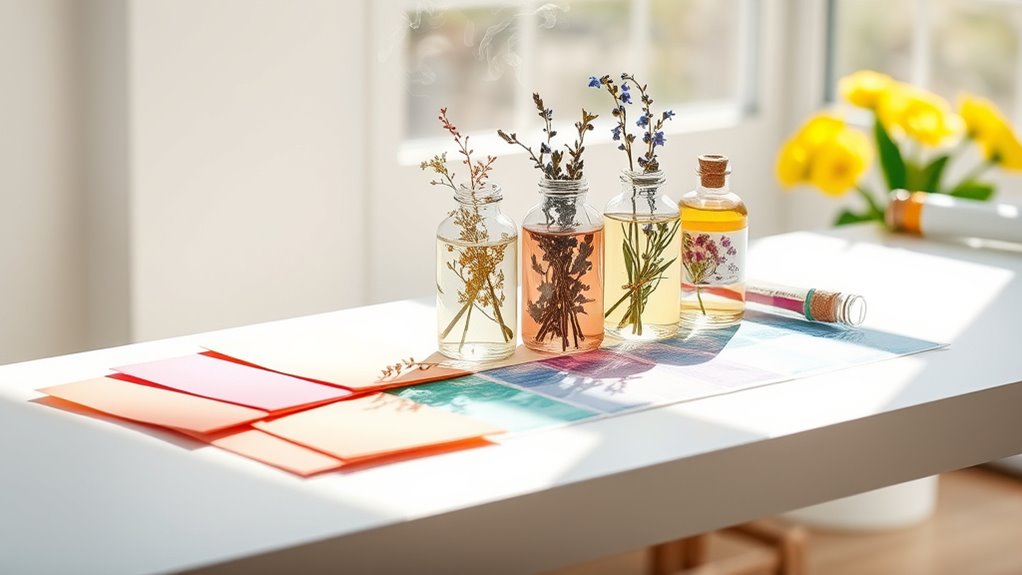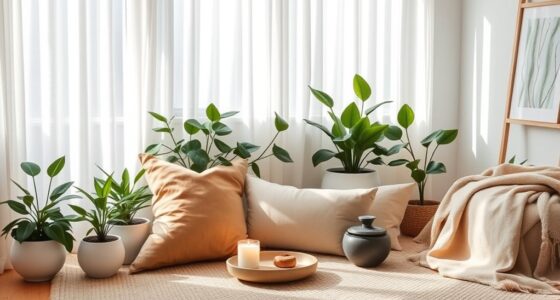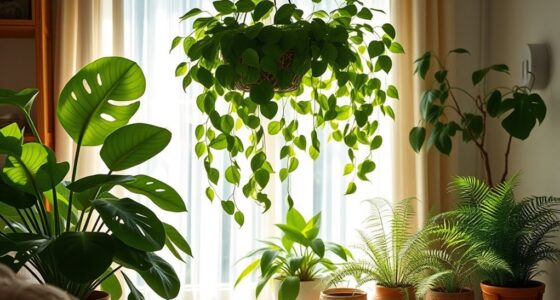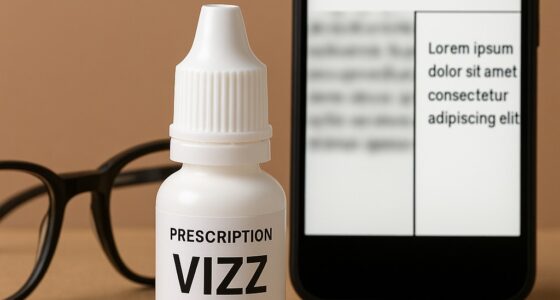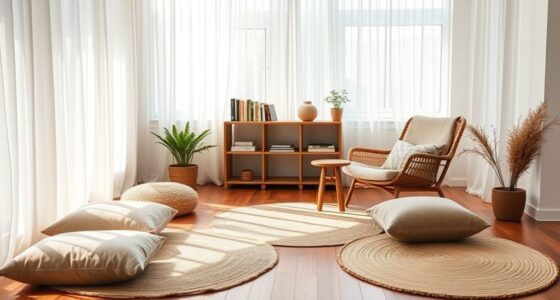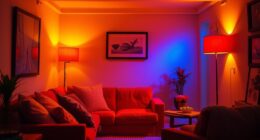Pairing specific scents with paint hues can considerably boost your mood and create the perfect environment. For calming spaces, use soothing colors like soft blues or greens combined with lavender or eucalyptus scents. Energize rooms with vibrant reds or oranges paired with citrus or peppermint aromas. Neutral tones work well with rosemary or vanilla to promote clarity and comfort. By intentionally matching colors and fragrances, you can craft spaces that support your emotional well-being—exploring these ideas further reveals even more effective combinations.
Key Takeaways
- Pair soft blues and greens with lavender or eucalyptus scents to enhance calmness and relaxation.
- Use vibrant reds or oranges combined with citrus or peppermint aromas to energize and motivate.
- Match warm hues like amber or deep yellow with cinnamon or vanilla scents to create cozy, comforting atmospheres.
- Select cool tones with rosemary or peppermint fragrances to promote focus and mental clarity.
- Intentionally combine paint hues and fragrances to craft environments that boost mood and emotional well-being.
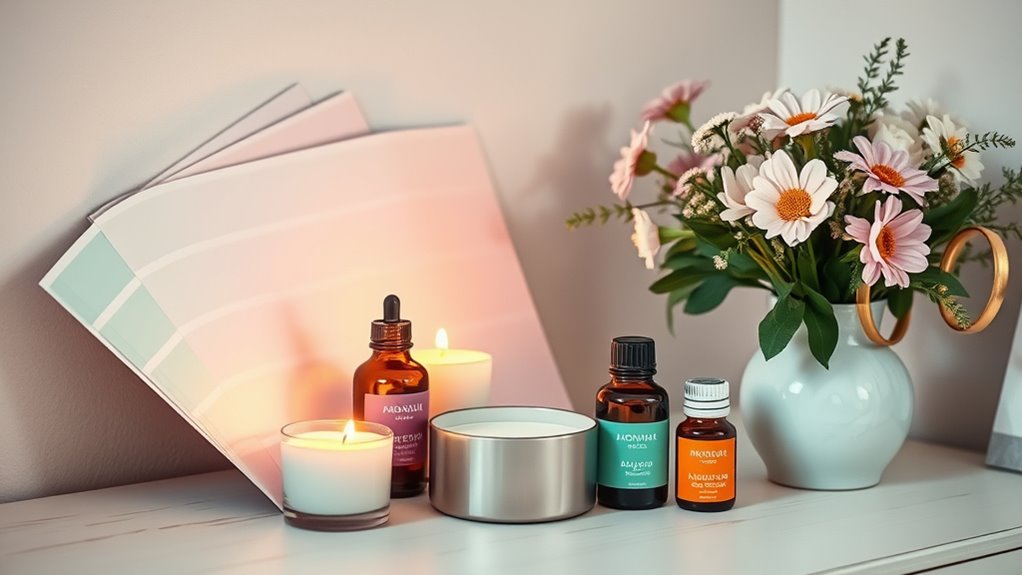
Have you ever noticed how certain colors seem to evoke specific scents or feelings? “Color Scents” explores the fascinating connection between hues and fragrances, revealing how our perceptions of color can influence our sensory experiences. When you understand this link, you can intentionally pair paint hues with scents to create environments that boost your mood and enhance your well-being. This is where aroma therapy and scent psychology come into play. Aroma therapy uses fragrances to promote relaxation or invigoration, while scent psychology examines how different smells impact our emotions and behaviors. By combining these principles with color choices, you can craft spaces that resonate with your desired emotional state.
For example, soft blues and greens are often associated with calmness and serenity. To amplify this effect, you might incorporate lavender or eucalyptus scents, which are known for their relaxing qualities in aroma therapy. These scents can deepen the tranquil atmosphere, making your space a perfect retreat for stress relief or meditation. Conversely, vibrant reds and oranges are linked to energy and enthusiasm. Pairing these bold hues with invigorating scents like citrus or peppermint can help boost your motivation and alertness. Scent psychology suggests that these combinations stimulate your senses, encouraging feelings of excitement and vitality.
When designing a space for focus or productivity, consider using neutral or earthy tones like beige, taupe, or terracotta. These colors promote stability and concentration. Adding a subtle scent such as rosemary or peppermint can further enhance mental clarity, tapping into aroma therapy’s ability to sharpen focus. On the other hand, if you want to cultivate a cozy, welcoming atmosphere, warm hues like amber, rust, or deep yellow work well. Complement these with cinnamon or vanilla scents, which evoke comfort and warmth, thanks to their grounding effects highlighted in scent psychology. These pairings can make your environment feel inviting and safe.
Understanding how color and scent influence mood allows you to be intentional in your design choices. Whether you’re creating a peaceful sanctuary or an energizing workspace, aligning your color palette with specific fragrances can elevate your sensory experience. As research indicates, AI safety measures and monitoring can ensure that your environment remains harmonious and safe, especially when utilizing advanced technology or AI-enhanced systems. This approach taps into the science of aroma therapy and scent psychology, making your environment work for your emotional and mental health. By consciously pairing hues with fragrances, you craft spaces that do more than look good—they feel good, too. This harmony of color and scent helps you foster a mood, nurture relaxation, or ignite motivation, all through simple, intentional choices.
Frequently Asked Questions
How Do Scent and Color Combinations Influence Sleep Quality?
You might find that scent and color combinations markedly influence your sleep quality by enhancing your sleep environment. Soft, calming colors like blue or lavender paired with soothing aromas such as chamomile or lavender promote relaxation. Using these relaxation techniques can help ease your mind before bed, making it easier to fall asleep and stay asleep longer. Experimenting with gentle hues and gentle scents creates a peaceful space that supports restful sleep.
Can Scent and Color Pairing Improve Productivity in Workspaces?
You can boost productivity in your workspace by applying scent psychology and color therapy principles. Choose invigorating scents like citrus or peppermint to energize, and pair them with bright, stimulating colors like yellow or light green. These combinations can enhance focus and motivation. By intentionally pairing aromas with specific hues, you create an environment that promotes alertness, helping you stay productive and engaged throughout your workday.
Are There Any Safety Considerations When Using Essential Oils With Paint?
When using essential oils with paint, you should consider essential oil safety and paint compatibility. Always verify the essential oils you choose are safe to mix with your specific paint type, avoiding those that could cause discoloration or damage. Ventilate the area well during application, and test a small patch first. Stick to recommended dilutions to prevent adverse reactions and ensure a safe, pleasant environment.
How Long Do the Mood Effects of Scent and Color Pairing Last?
Research shows that scent and color pairing can boost your mood for about two to four hours. The duration effects depend on factors like scent strength and your environment. Typically, the permanence of pairing fades as the scent dissipates or your mood adapts. To prolong positive effects, consider reapplying aromas or changing colors periodically. Keep in mind, individual responses vary, so staying mindful of your mood helps optimize the benefits.
Can Scent and Color Pairing Help Alleviate Specific Emotional Issues?
You might find that scent and color pairing can support emotional healing and stress reduction. By choosing calming aromas like lavender with soft blue hues, you create a soothing environment that helps ease anxiety or sadness. While it’s not a cure, this sensory combination can complement other emotional healing methods, fostering a sense of peace and balance. Incorporating these pairings into your space may enhance your overall emotional well-being.
Conclusion
Think of your space as a garden, where each scent and color is a blooming flower. When you pair the right aromas with paint hues, you create a vibrant landscape that uplifts your mood and nurtures your soul. Your environment becomes a sanctuary, a symphony of senses that refreshes and energizes you every day. Embrace these pairings, and watch your surroundings blossom into a haven of happiness and harmony.
